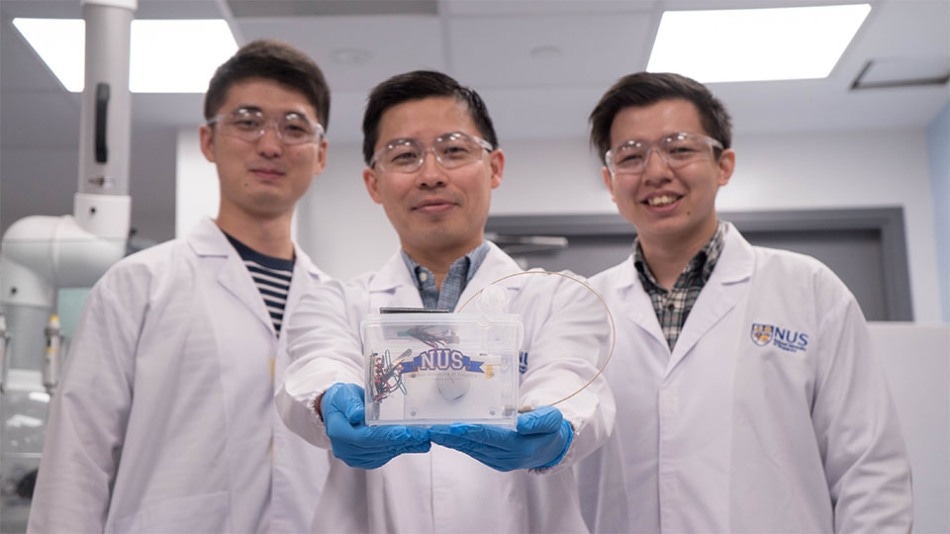Nov 27 2017
A research team at the National University of Singapore (NUS) has designed a prototype device that simulates natural photosynthesis to synthesize ethylene gas by using just water, sunlight, and carbon dioxide.
The innovative technique, which involves synthesizing ethylene at ambient temperature and pressure by using gentle chemicals, can be enhanced to offer a more sustainable and environment-friendly substitute to the prevalent technique for synthesizing ethylene.
 The NUS research team behind the artificial photosynthesis system that can produce ethylene using only sunlight, carbon dioxide and water. Credit: National University of Singapore
The NUS research team behind the artificial photosynthesis system that can produce ethylene using only sunlight, carbon dioxide and water. Credit: National University of Singapore
This advancement, headed by Assistant Professor Jason Yeo Boon Siang from the Department of Chemistry at NUS Faculty of Science and the Solar Energy Research Institute of Singapore (SERIS), was first reported in ACS Sustainable Chemistry & Engineering, a prestigious scientific journal.
Challenges of the current production of ethylene
Ethylene—a fundamental constituent of polyethylene—is a vital chemical feedstock synthesized in large amounts for producing fibers, rubber, and plastics. Over 170 million tons of ethylene was synthesized globally just in the year 2015. Moreover, by the year 2020, the worldwide requirement for ethylene has been anticipated to surpass 220 million tons.
Existing industrial synthesis of ethylene involves steam cracking of fossil fuels at 750-950°C, which requires a huge amount of energy and greater quantities of natural fuel resources. In the existing technique, nearly two tons of carbon dioxide is emitted for each ton of ethylene synthesized, thereby leaving behind a considerable carbon footprint. In essence, there is an ever-increasing requirement for an environmently-friendly and highly sustainable method for synthesizing ethylene.
Adopting artificial photosynthesis
Assistant Professor Yeo and his colleagues identified the necessity for a more environment-friendly technique; therefore, they adopted renewable energy to synthesize ethylene. Initially, in 2015, the researchers developed a copper catalyst with the ability to generate ethylene from readily accessible carbon dioxide and water upon being powered by electricty. Then, the copper catalyst was fed into an artificial photosynthesis system to transform water and carbon dioxide into ethylene by using just solar power. The prototype device developed to perform the reaction accomplished a 30% faradaic efficiency of ethylene dependent on the quantity of electrons producing using solar power. The gross energy efficiency of solar-to-ethylene conversion is also commensurate with the energy efficiency level of natural photosynthesis performed by plants.
Carbon capture is a key step in fighting human-driven climate change. There has been a steady increase in the atmospheric concentration of carbon dioxide, because the rate of carbon dioxide emissions exceeds that of carbon capture. This has been attributed as a major cause of global warming which leads to undesirable environmental changes. Our device not only employs a completely renewable energy source, but also converts carbon dioxide, a greenhouse gas into something useful. This could potentially close the carbon cycle.
Assistant Professor Jason Yeo Boon Siang from the Department of Chemistry at NUS Faculty of Science and the Solar Energy Research Institute of Singapore (SERIS)
In addition to this, the researchers included a battery into the prototype device to achieve continuous and stable synthesis of ethylene, a significant difficulty in artificial photosynthesis systems. The battery stores the surplus solar power gathered during the daytime to power up the equipment during night or during low-light conditions, thereby making sure that the operations are not hindered by the alterations in solar power in an entire day.
The innovation is an important landmark in developing a scalable artificial photosynthesis system for sustainable and clean synthesis of significant organic molecules such as ethylene.
In the future, the researchers will constantly develop their device to increase the synthesis of ethylene and will also use similar systems to synthesize liquid fuels, for example, propanol and ethanol.